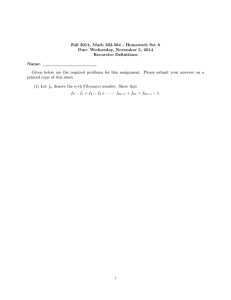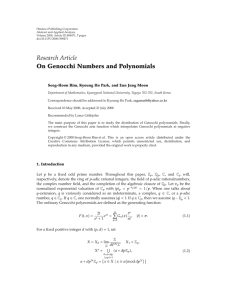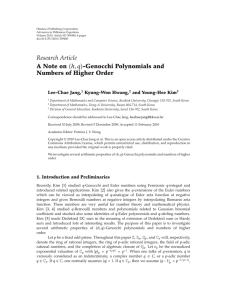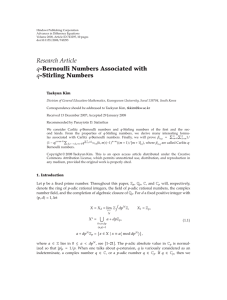Document 10833426
advertisement
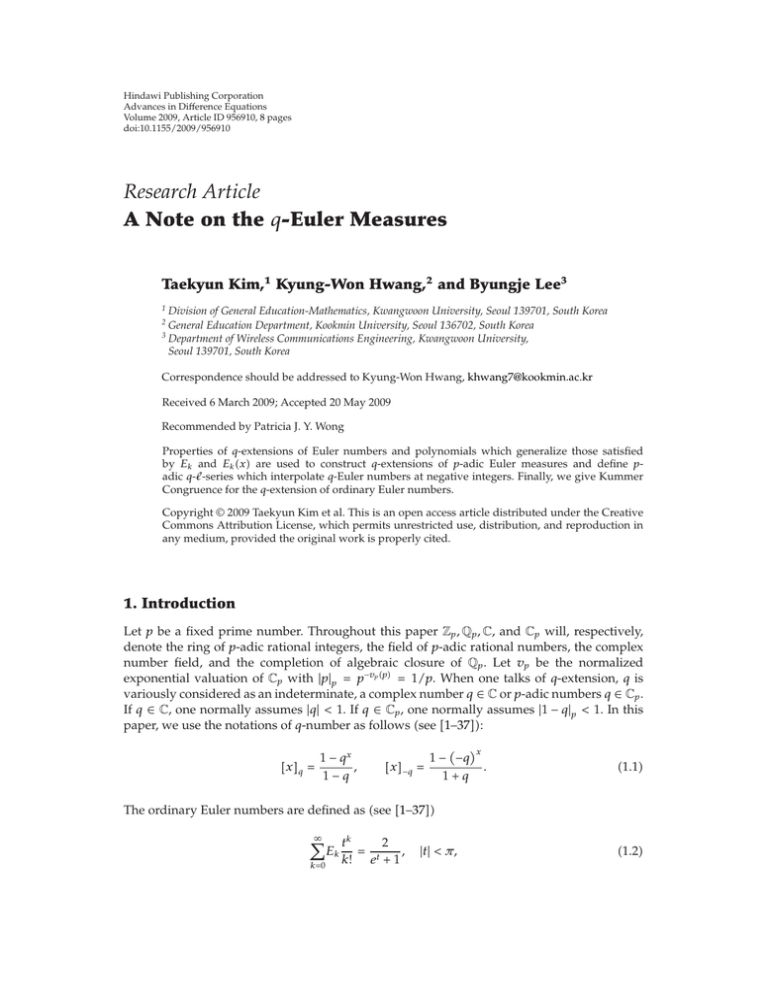
Hindawi Publishing Corporation Advances in Difference Equations Volume 2009, Article ID 956910, 8 pages doi:10.1155/2009/956910 Research Article A Note on the q-Euler Measures Taekyun Kim,1 Kyung-Won Hwang,2 and Byungje Lee3 1 Division of General Education-Mathematics, Kwangwoon University, Seoul 139701, South Korea General Education Department, Kookmin University, Seoul 136702, South Korea 3 Department of Wireless Communications Engineering, Kwangwoon University, Seoul 139701, South Korea 2 Correspondence should be addressed to Kyung-Won Hwang, khwang7@kookmin.ac.kr Received 6 March 2009; Accepted 20 May 2009 Recommended by Patricia J. Y. Wong Properties of q-extensions of Euler numbers and polynomials which generalize those satisfied by Ek and Ek x are used to construct q-extensions of p-adic Euler measures and define padic q--series which interpolate q-Euler numbers at negative integers. Finally, we give Kummer Congruence for the q-extension of ordinary Euler numbers. Copyright q 2009 Taekyun Kim et al. This is an open access article distributed under the Creative Commons Attribution License, which permits unrestricted use, distribution, and reproduction in any medium, provided the original work is properly cited. 1. Introduction Let p be a fixed prime number. Throughout this paper Zp , Qp , C, and Cp will, respectively, denote the ring of p-adic rational integers, the field of p-adic rational numbers, the complex number field, and the completion of algebraic closure of Qp . Let vp be the normalized exponential valuation of Cp with |p|p p−vp p 1/p. When one talks of q-extension, q is variously considered as an indeterminate, a complex number q ∈ C or p-adic numbers q ∈ Cp . If q ∈ C, one normally assumes |q| < 1. If q ∈ Cp , one normally assumes |1 − q|p < 1. In this paper, we use the notations of q-number as follows see 1–37: 1 − qx , xq 1−q x−q x 1 − −q . 1q 1.1 The ordinary Euler numbers are defined as see 1–37 ∞ k0 Ek tk 2 t , k! e 1 |t| < π, 1.2 2 Advances in Difference Equations where 2/et 1 is written as eEt when Ek is replaced by Ek . From the definition of Euler number, we can derive E 1n En 0, E0 1, if n > 0, 1.3 with the usual convention of replacing Ei by Ei . Remark 1.1. The second kind Euler numbers are also defined as follows see 25: sech t ∞ k 2 2et ∗t E k et e−t e2t 1 k0 k! |t| < π . 2 1.4 The Euler polynomials are also defined by ∞ 2 tn xt Ext e e En x , t n! e 1 n0 |t| < π. 1.5 Thus, we have En x n n k k0 1.6 Ek xn−k . In 7, q-Euler numbers, Ek,q , can be determined inductively by k q qEq 1 Ek,q 0 E0,q 1, if k > 0, 1.7 where Eqk must be replaced by Ek,q , symbolically. The q-Euler polynomials Ek,q x are given by qx Eq xq k , that is, Ek,q x q Eq xq x k k k Ei,q qix xk−i q . i i0 1.8 Let d be a fixedodd positive integer. Then we have see 7 2q 2qd dnq d−1 a0 qa −1a En,q x a d En,q x, for n ∈ Z . 1.9 We use 1.9 to get bounded p-adic q-Euler measures and finally take the Mellin transform to define p-adic q--series which interpolate q-Euler numbers at negative integers. Advances in Difference Equations 3 2. p-adic q-Euler Measures Let d be a fixed odd positive integer, and let p be a fixed odd prime number. Define Z X Xd lim , X1 Zp , ←− dpN Z N X∗ a dpZp , 2.1 0<a<dp, a,p1 a dpN Zp x ∈ X | x ≡ a mod dpN , where a ∈ Z lies in 0 ≤ a < dpN , see 1–37. E Theorem 2.1. Let μk,q be given by E μk,q a dp Zp N N k dp q a N qa −1a Ek,qdpN , dpN dp −q for k ∈ Z , N ∈ N. E 2.2 E Then μk,q extends to a Qq-valued measure on the compact open sets U ⊂ X. Note that μ0,q μ−q , where μ−q a dpN Zp −qa /dpN −q is fermionic measure on X (see [7]). Proof. It is sufficient to show that p−1 E E μk,q a idpN dpN1 Zp μk,q a dpN Zp . i0 By 1.9 and 2.2, we see that p−1 E μk,q a idpN dpN1 Zp i0 k p−1 dpN1 q a idpN aidpN aidpN N1 q Ek,qdpN1 −1 dpN1 dp −q i0 k p−1 i dpN1 q a/dpN i a i a dpN q N q −1 −1 Ek,qdpN p p dp −q i0 k p−1 i dpN q 2qdpN k a/dpN i a i a dpN p N q −1 q p qdpN −1 Ek,qdpN p 2qdpN1 dp −q i0 2.3 4 Advances in Difference Equations k p−1 i dpN q 2qdpN k a/dpN i a i a dpN p N q −1 q p qdpN −1 Ek,qdpN p 2qdpN p dp −q i0 k dpN q a E N N qa −1a Ek,qdpN a dp , μ Z p k,q dpN dp −q 2.4 E and we easily see that |μk,q | ≤ M for some constant M. p Let χ be a Dirichlet character with conductor d ∈ N with d ≡ 1mod 2. Then we define the generalized q-Euler numbers attached to χ as follows: Ek,χ,q 2q 2qd dkq d−1 qx −1x χxEk,qd x x0 d . 2.5 The locally constant function χ on X can be integrated by the p-adic bounded q-Euler measure E μk,q as follows: E X χxdμk,q x lim N →∞ 0≤x<dpN E χxμk,q x dpN Zp N k dp q a xd adx adx χa dxq Ek,qdpN lim N −1 N → ∞ dp dpN −q 0≤a<d 0≤x<pN N k p qd χa−1 q lim N N →∞ p 2qd 0≤a<d −qd x a/d x qd −1x E d pN × k,q pN 0≤x<pN 2q 2q 2qd dkq dkq a a χa−1a qa Ek,qd 0≤a<d a d Ek,χ,q , a n 2q 2qp E χxdμk,q x p q χ pa qpa −1a En,qdp dnqp d 2qp 2qpd pX 0≤a<d a n 2q 2qp n a pa χ p p q χaq −1 En,qdp dqp d 2qp 2qpd 0≤a<d n 2q En,χ,qp . χ p p q 2qp 2.6 Therefore, we obtain the following theorem. Advances in Difference Equations 5 Theorem 2.2. Let χ be the Dirichlet character with conductor d ∈ N with d ≡ 1mod 2. Then one has E X χxdμk,q x Ek,χ,q , X∗ E χxdμk,q x k 2q E χxdμk,q x χ p p q Ek,χ,qp , 2qp pX k 2q Ek,χ,qp . Ek,χ,q − χ p p q 2qp 2.7 Let k ∈ Z . From 2.2, we note that E μk,q a dpN Zp N k dp q a a a N q −1 Ek,qdpN dpN dp −q N k k dp q k a k−i a a Ei,qdpN qai N q −1 dpN qdpN dp −q i i0 2.8 N k k dp q ak−i k q a a N q −1 Ei,qdpN qai k−i N dp −q i dp i0 q −q a N dp −q akq N k k dp q ak−i k q a a Ei,qdpN qai N q −1 k−i . N dp −q i dp i1 q Thus, we have E dμk,q x xkq dμ−q x. 2.9 Therefore, we obtain the following theorem and corollary. Theorem 2.3. For k ≥ 0, one has E dμk,q x xkq dμ−q x. 2.10 Corollary 2.4. For k ≥ 0, one has X E dμk,q x X xkq dμ−q x Ek,q . 2.11 6 Advances in Difference Equations 3. p-adic q--Series In this section, we assume that q ∈ Cp with |1 − q|p < p−1/p−1 . Let ω denote the Teichmüller character mod p. For x ∈ X ∗ , we set xq xq /ωx. Note that |xq − 1|p < p−1/p−1 , and xsq is defined by exps logp xq , for |s|p ≤ 1. For s ∈ Zp ,we define p,q s, χ X∗ x−s q χxdμ−q x. 3.1 Thus, we have p,q −k, χω k X∗ xkq χxdμ−q x E X∗ χxdμk,q x k 2q Ek,χ,qp , Ek,χ,q − χ p p q 2qp 3.2 for k ∈ Z . n Since |xq − 1|p < p−1/p−1 for x ∈ X ∗ , we have xp ≡ 1mod pn . Let k ≡ k mod pn p − 1. Then we have p,q −k, χωk ≡ p,q −k , χωk mod pn . 3.3 Therefore, we obtain the following theorem. Theorem 3.1. Let k ≡ k mod p − 1pn . Then one has Ek,χ,q − 2q k 2q k χ p p q Ek,χ,qp ≡ Ek ,χ,q − χ p p q Ek ,χ,qp mod pn . 2qp 2qp 3.4 Acknowledgments This paper was supported by Jangjeon Mathematical Society. References 1 M. Cenkci, “The p-adic generalized twisted h, q-Euler-l-function and its applications,” Advanced Studies in Contemporary Mathematics, vol. 15, no. 1, pp. 37–47, 2007. 2 M. Cenkci, Y. Simsek, and V. Kurt, “Further remarks on multiple p-adic q-L-function of two variables,” Advanced Studies in Contemporary Mathematics, vol. 14, no. 1, pp. 49–68, 2007. 3 M. Cenkci, M. Can, and V. Kurt, “p-adic interpolation functions and Kummer-type congruences for q-twisted Euler numbers,” Advanced Studies in Contemporary Mathematics, vol. 9, no. 2, pp. 203–216, 2004. 4 T. Kim, “q-extension of the Euler formula and trigonometric functions,” Russian Journal of Mathematical Physics, vol. 14, no. 3, pp. 275–278, 2007. 5 T. Kim, “On the multiple q-Genocchi and Euler numbers,” Russian Journal of Mathematical Physics, vol. 15, no. 4, pp. 481–486, 2008. Advances in Difference Equations 7 6 S.-H. Rim and T. Kim, “A note on p-adic Euler measure on Zp ,” Russian Journal of Mathematical Physics, vol. 13, no. 3, pp. 358–361, 2006. 7 T. Kim, “q-Euler numbers and polynomials associated with p-adic q-integrals,” Journal of Nonlinear Mathematical Physics, vol. 14, no. 1, pp. 15–27, 2007. 8 J. V. Leyendekkers, A. G. Shannon, and C. K. Wong, “Integer structure analysis of the product of adjacent integers and Euler’s extension of Fermat’s last theorem,” Advanced Studies in Contemporary Mathematics, vol. 17, no. 2, pp. 221–229, 2008. 9 H. Ozden, I. N. Cangul, and Y. Simsek, “Remarks on sum of products of h, q-twisted Euler polynomials and numbers,” Journal of Inequalities and Applications, vol. 2008, Article ID 816129, 8 pages, 2008. 10 H. M. Srivastava, T. Kim, and Y. Simsek, “q-Bernoulli numbers and polynomials associated with multiple q-zeta functions and basic L-series,” Russian Journal of Mathematical Physics, vol. 12, no. 2, pp. 241–268, 2005. 11 T. Kim, “Note on q-Genocchi numbers and polynomials,” Advanced Studies in Contemporary Mathematics, vol. 17, no. 1, pp. 9–15, 2008. 12 T. Kim, “The modified q-Euler numbers and polynomials,” Advanced Studies in Contemporary Mathematics, vol. 16, no. 2, pp. 161–170, 2008. 13 T. Kim, “On a q-analogue of the p-adic log gamma functions and related integrals,” Journal of Number Theory, vol. 76, no. 2, pp. 320–329, 1999. 14 T. Kim, “q-Volkenborn integration,” Russian Journal of Mathematical Physics, vol. 9, no. 3, pp. 288–299, 2002. 15 T. Kim, “q-Bernoulli numbers and polynomials associated with Gaussian binomial coefficients,” Russian Journal of Mathematical Physics, vol. 15, no. 1, pp. 51–57, 2008. 16 T. Kim, J. Y. Choi, and J. Y. Sug, “Extended q-Euler numbers and polynomials associated with fermionic p-adic q-integral on Zp ,” Russian Journal of Mathematical Physics, vol. 14, no. 2, pp. 160–163, 2007. 17 T. Kim, “On the von Staudt-Clausen’s Theorem for the q-Euler numbers,” Russian Journal of Mathematical Physics, vol. 16, no. 3, 2009. 18 T. Kim, “q-generalized Euler numbers and polynomials,” Russian Journal of Mathematical Physics, vol. 13, no. 3, pp. 293–298, 2006. 19 T. Kim, “Multiple p-adic L-function,” Russian Journal of Mathematical Physics, vol. 13, no. 2, pp. 151– 157, 2006. 20 T. Kim, “Power series and asymptotic series associated with the q-analog of the two-variable p-adic L-function,” Russian Journal of Mathematical Physics, vol. 12, no. 2, pp. 186–196, 2005. 21 T. Kim, “Analytic continuation of multiple q-zeta functions and their values at negative integers,” Russian Journal of Mathematical Physics, vol. 11, no. 1, pp. 71–76, 2004. 22 T. Kim, “On Euler-Barnes multiple zeta functions,” Russian Journal of Mathematical Physics, vol. 10, no. 3, pp. 261–267, 2003. 23 T. Kim, “Symmetry p-adic invariant integral on Zp for Bernoulli and Euler polynomials,” Journal of Difference Equations and Applications, vol. 14, no. 12, pp. 1267–1277, 2008. 24 T. Kim, “Non-Archimedean q-integrals associated with multiple Changhee q-Bernoulli polynomials,” Russian Journal of Mathematical Physics, vol. 10, no. 1, pp. 91–98, 2003. 25 T. Kim, “Euler numbers and polynomials associated with zeta functions,” Abstract and Applied Analysis, vol. 2008, Article ID 581582, 11 pages, 2008. 26 T. Kim, Y.-H. Kim, and K.-W. Hwang, “On the q-extensions of the Bernoulli and Euler numbers, related identities and Lerch zeta function,” Proceedings of the Jangjeon Mathematical Society, vol. 12, pp. 1–16, 2009. 27 M. Schork, “Ward’s “calculus of sequences”, q-calculus and the limit q → −1,” Advanced Studies in Contemporary Mathematics, vol. 13, no. 2, pp. 131–141, 2006. 28 Y. Simsek, “Theorems on twisted L-function and twisted Bernoulli numbers,” Advanced Studies in Contemporary Mathematics, vol. 11, no. 2, pp. 205–218, 2005. 29 Y. Simsek, “Generating functions of the twisted Bernoulli numbers and polynomials associated with their interpolation functions,” Advanced Studies in Contemporary Mathematics, vol. 16, no. 2, pp. 251– 278, 2008. 30 Z. Zhang and H. Yang, “Some closed formulas for generalized Bernoulli-Euler numbers and polynomials,” Proceedings of the Jangjeon Mathematical Society, vol. 11, no. 2, pp. 191–198, 2008. 8 Advances in Difference Equations 31 Y. Simsek, O. Yurekli, and V. Kurt, “On interpolation functions of the twisted generalized FrobeniusEuler numbers,” Advanced Studies in Contemporary Mathematics, vol. 15, no. 2, pp. 187–194, 2007. 32 Y. Simsek, “On p-adic twisted q-L-functions related to generalized twisted Bernoulli numbers,” Russian Journal of Mathematical Physics, vol. 13, no. 3, pp. 340–348, 2006. 33 H. Ozden, Y. Simsek, S.-H. Rim, and I. N. Cangul, “A note on p-adic q-Euler measure,” Advanced Studies in Contemporary Mathematics, vol. 14, no. 2, pp. 233–239, 2007. 34 H. Ozden, I. N. Cangul, and Y. Simsek, “Multivariate interpolation functions of higher-order q-Euler numbers and their applications,” Abstract and Applied Analysis, vol. 2008, Article ID 390857, 16 pages, 2008. 35 H. J. H. Tuenter, “A symmetry of power sum polynomials and Bernoulli numbers,” The American Mathematical Monthly, vol. 108, no. 3, pp. 258–261, 2001. 36 M. Cenkci, Y. Simsek, and V. Kurt, “Multiple two-variable p-adic q-L-function and its behavior at s 0,” Russian Journal of Mathematical Physics, vol. 15, no. 4, pp. 447–459, 2008. 37 K. T. Atanassov and M. V. Vassilev-Missana, “On one of Murthy-Ashbacher’s conjectures related to Euler’s totient function,” Proceedings of the Jangjeon Mathematical Society, vol. 9, no. 1, pp. 47–49, 2006.
